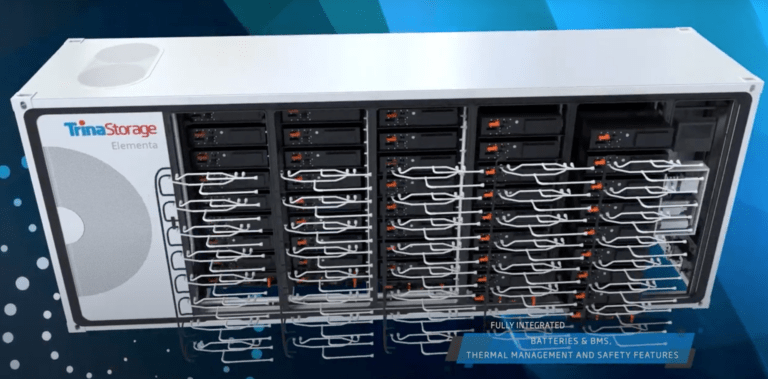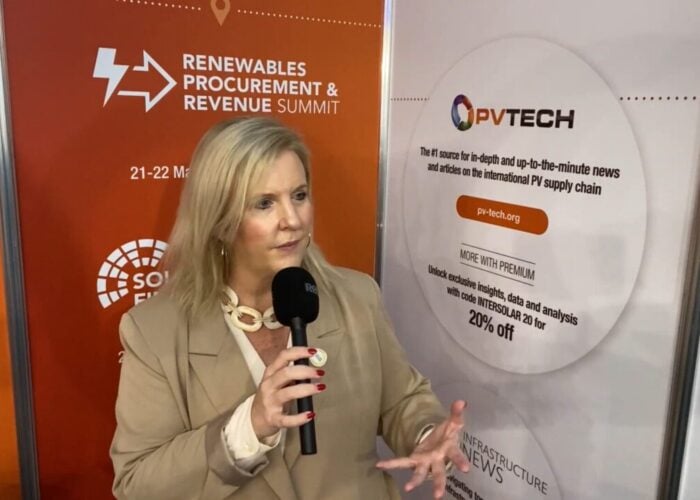
Entering an advanced technology market already populated with large, established suppliers is never easy but Trina Solar’s head of overseas storage, Terry Chen, is unperturbed because of a faith in his company’s product and the advantages that late entry can bring.
PV Tech caught up with Chen at this year’s Intersolar in Munich, Germany where Trina Solar’s storage business unit was making its first “grand appearance” since its formation in February. Alongside promoting Trina Solar’s normal wares, Trina Storage was there for a soft launch for its new lithium iron phosphate (LFP) utility-scale battery storage cabinet, Elementa, which Chen believes can make serious strides into the energy storage market, unsettling more established competitors.
Unlock unlimited access for 12 whole months of distinctive global analysis
Photovoltaics International is now included.
- Regular insight and analysis of the industry’s biggest developments
- In-depth interviews with the industry’s leading figures
- Unlimited digital access to the PV Tech Power journal catalogue
- Unlimited digital access to the Photovoltaics International journal catalogue
- Access to more than 1,000 technical papers
- Discounts on Solar Media’s portfolio of events, in-person and virtual
New kid on the storage block
Asked why Trina’s Elementa system should compete with or even worry competitors, Chen says it comes down to the storage system’s ability to save customers up to 5% on their capex costs versus the top five mainstream competitors. Its standardised design helps reduce installation times by up to 70% and customers can also save 90% of required cabling materials.
Chen says the trade show was a great opportunity for Trina to get the word out to an international audience, “show its muscle” and position itself alongside its competitors.
“We know [competitors’] products and what they’re offering,” he says.
“We know their weaknesses and what can be improved from a technology perspective.”
Elementa is a fully-integrated and modular storage solution with a plug-in concept that allows site operators to connect multiple units easily, Chen explains.
This means that even the largest projects can scale up their storage as and when required which also leads to lower capex through simpler on-site connections. It has a minimum capacity of 1.8MWh and a nominal C-rate of between 0.25-1C. Trina Storage claims it also enables easy maintenance and higher availability as the bi-directional flow liquid cooling system provides uniform heat dissipation which means longer battery lifetime and better performance.
This is all part of Trina’s desire to create a vertically integrated approach to the “booming” global energy storage market, with a focus on utility-scale market segments. Back at Trina Storage’s launch in February, covered by our sister site Energy-Storage.news, Chen said the division was geared towards providing a “competitive solutions platform” using leading batteries, power conversion systems (PCS) and controls and battery management systems (BMS), with Trina set to continue investing in R&D in those areas.
“We are using the best battery system in the world and in the meantime, from an integration technology perspective, we have better management and cooling systems with our unique design for the pack,” he tells PV Tech. “Our dual cooling system can dramatically increase our server management efficiency by up to 5%, that means more reliability and better longevity.”
The overall strategy, therefore, is to create an “energy solutions provider, not an integrator or manufacturer”, Chen said at the time of the February launch, and Trina Storage will select or develop its own top-tier products to integrate into battery systems.
The development of modular, more standardised ESS products and solutions, stackable at megawatt-hour scale, is a general trend from many other providers in the industry, such as Tesla, Leclanche, Saft, Fluence and more.

Quiet confidence comes from belief in the brand
Regardless of what competitors are doing, Chen believes a faith in the Trina brand means customers would be willing to purchase storage solutions from a new market entrant over an incumbent.
“We’re a global company with a very good reputation, so customers already trust Trina,” he says.
Trina Storage has also amassed a “very strong team from both a technical and commercial perspective” says Chen, with members coming from the likes of Tesla, GE and other prominent technology companies in the solar space.
Other competitors would also have higher overheads as Trina could “leverage its global infrastructure to reduce costs”, Chen says, while its Chinese competitors did not offer as professional a service or customer interface.
That said, Chen does recognise the enormity of the task ahead if Trina wants to be a major player in the storage game. “Competition from existing competitors and new entrants with strong battery profile are some of our biggest challenges,” he says. “There is a clear trend we can foresee, with competition being even more consolidated.”
Moreover, some of the stats reference so far are based on Trina’s first battery storage project – a 50MW grid-scale system in Cambridgeshire, United Kingdom. Owned by smart energy infrastructure company SMS, Trina was engaged to supply a battery energy storage system (BESS). PV Tech’s sister site Solar Power Portal wrote about the project when it was announced in February.
Chen says he hopes to have the project off the ground before the end of 2022 and, once complete, it will provide the UK’s National Grid with balancing services. The project demonstrated Trina Storage’s potential as a major playing in the battery storage space, he says.
Analyses based on just one site, however, are not representative, and an Elementa brochure said that capex expenditure considerations such as cable length and reduced weight could vary with project requirements.
Nonetheless, Trina and Chen are confident about Elementa’s chances to ruffle some storage feathers and, if replicated across different sites, it represents an attractive offer to customers.
“I want Trina Storage to be one of most competitive storage companies in the world in terms of branding, market share and profitability,” Chen says.
It will come down to whether Trina is able to leverage it brand name, global infrastructure and solar expertise to good enough effect to pose a challenge to its rivals.
An official launch of Elementa is scheduled for the beginning of next year.







